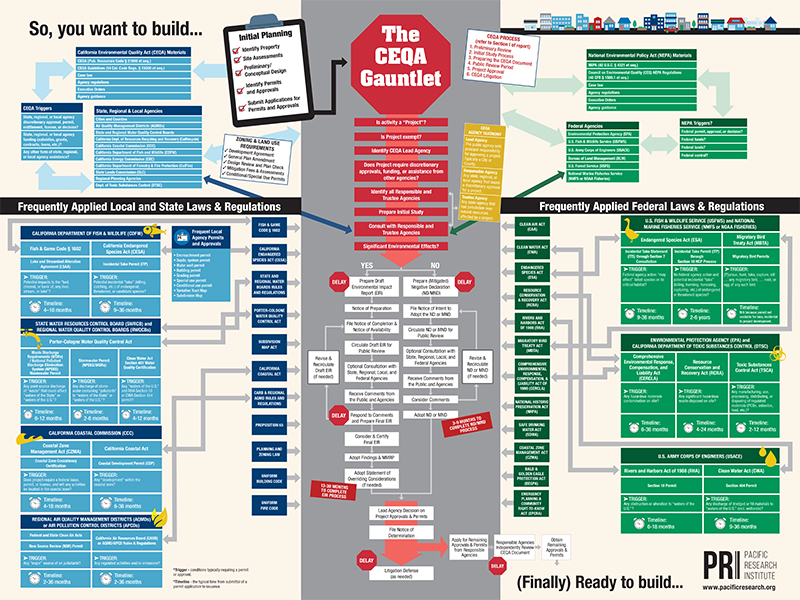Morphing from a once-reasonable requirement that building permit applicants report on the “significant environmental impact” of their construction project and how they intend to mitigate that impact, CEQA is now a process-heavy, bureaucratic beast that delays projects for years and costs developers millions. Of all the ways California’s Legislature and state agencies are trying to elevate prices for everything in the state, CEQA is the worst.
But the new laws and other CEQA-related bills California’s enlightened legislators are expeditiously moving towards passage are not addressing CEQA’s fundamental flaws. They aren’t restricting the right to litigate under CEQA to district attorneys, which would stop opportunistic lawsuits by extortionate third parties, or requiring the loser to pay legal fees in frivolous lawsuits. Nor are they limiting, across the board, the time periods allowed for permit processing and appeals (although one measure is attempting to impose some deadlines). These steps would rectify CEQA for everyone, but everyone is not a concern.
Instead, California’s Legislature is exempting favored projects from the excesses of CEQA, specifically those having to do with “water, transportation, clean energy and housing.” While we may hope that “water” might at least include finally building the badly needed Sites Reservoir, “transportation” means throwing more money at light-rail projects, “clean” energy means more utility scale solar, wind and battery farms, and “housing,” of course, means more high-density infill.
Just how dense the Legislature will require housing to get in order to be exempt from CEQA provisions is found in the State Government Code Title 7, Division 1, Chapter 3, Article 10.6 “Housing Elements,” where the “lowest” permissible density is 10 units per acre. That would only be allowable, however, in an “unincorporated area of a nonmetropolitan county.” If the area is incorporated, it’s 15 units per acre. If the site is in a “suburban jurisdiction,” 20 units per acre, and if that suburban jurisdiction is in a “metropolitan county,” 30 units per acre.
This is the vision of the YIMBY (Yes In My Backyard) movement, supported by land developers who feed on subsidies and tax incentives, large-scale developers who have in-house bureaucracies primed to navigate the Byzantium otherwise known as the California Code. And this is the promise of “infill,” that moral imperative that deems any development outside of existing urban boundaries to be a crime against the planet. But why?
As the Free Cities Center has often argued, these exemptions are a step forward. Any sort of CEQA reform is progress. We’re glad the governor used his political capital to force through broader exemptions. But the state will not solve its housing problems until lawmakers focus on reforming the law broadly—and not just for their favored high-density projects. A report by YIMBY Law has found that these targeted exemptions haven’t produced much housing.
If greenhouse gas caused by long commutes is the concern, how does that take into account the fact that people increasingly work from home, or that automotive technology is allegedly—at least according to the California Legislature—becoming Earth friendly? How does that account for the reality that in every high-density urban area, automotive congestion increases air pollution, and the higher the density, the bigger the problem?
More to the point is the sheer absurdity of claiming California even has sprawling suburbs. The megacities of Los Angeles/San Diego and the San Francisco Bay Area are “sprawling” merely because that’s where everybody lives. California’s population grew relatively late compared to the rest of the nation, and most newcomers settled down in a few spots.
Contrary to perception, California’s urban density is the highest in America, with just over 94% of the population living on only 5% of the land. California’s urban areas have an average of nearly 4,800 people per square mile, also the nation’s highest.
The implications of this reveal the misanthropic cruelty of streamlining CEQA merely to further densify California’s urban areas. Forcing development into limited geographic areas, confined within “urban containment boundaries” is a large part of the reason housing is so expensive in California. This politically contrived shortage of available land for building causes the value of eligible land to rise well beyond what it would be worth if land could be developed outside existing urban areas.
Moreover, when developers build high density housing that has four or more floors, the cost per square foot increases compared to one- and two-story wood framed homes. These factors, all the result of political choices, are the reason housing is scarce and overpriced in California.
The greatest irony is that there is no need to limit the land where new housing projects are permitted. For example, if you built 2.5-million new homes on quarter acre lots, with an equal amount of land set aside for streets, parks, schools and commercial and industrial centers, and if each of these homes were occupied by four people, you could fit a population of 10 million into an area under 2,000 square miles. That ultra low density development would only increase California’s urban footprint from 5% to 6.2% of its total land. There is plenty of room.
Instead of recognizing this gift, and permitting practical water, energy and transportation infrastructure to realize it, California’s lawmakers prefer a hyper-regulated housing environment. That favors the wealthy, the politically connected and the subsidy hounds. But it denies private sector builders a chance to make a profit, without subsidies, building homes people want to buy, at a price they can afford.
Edward Ring is a co-founder of the California Policy Center and the author of ‘The Abundance Choice: Our Fight for More Water in California.’

